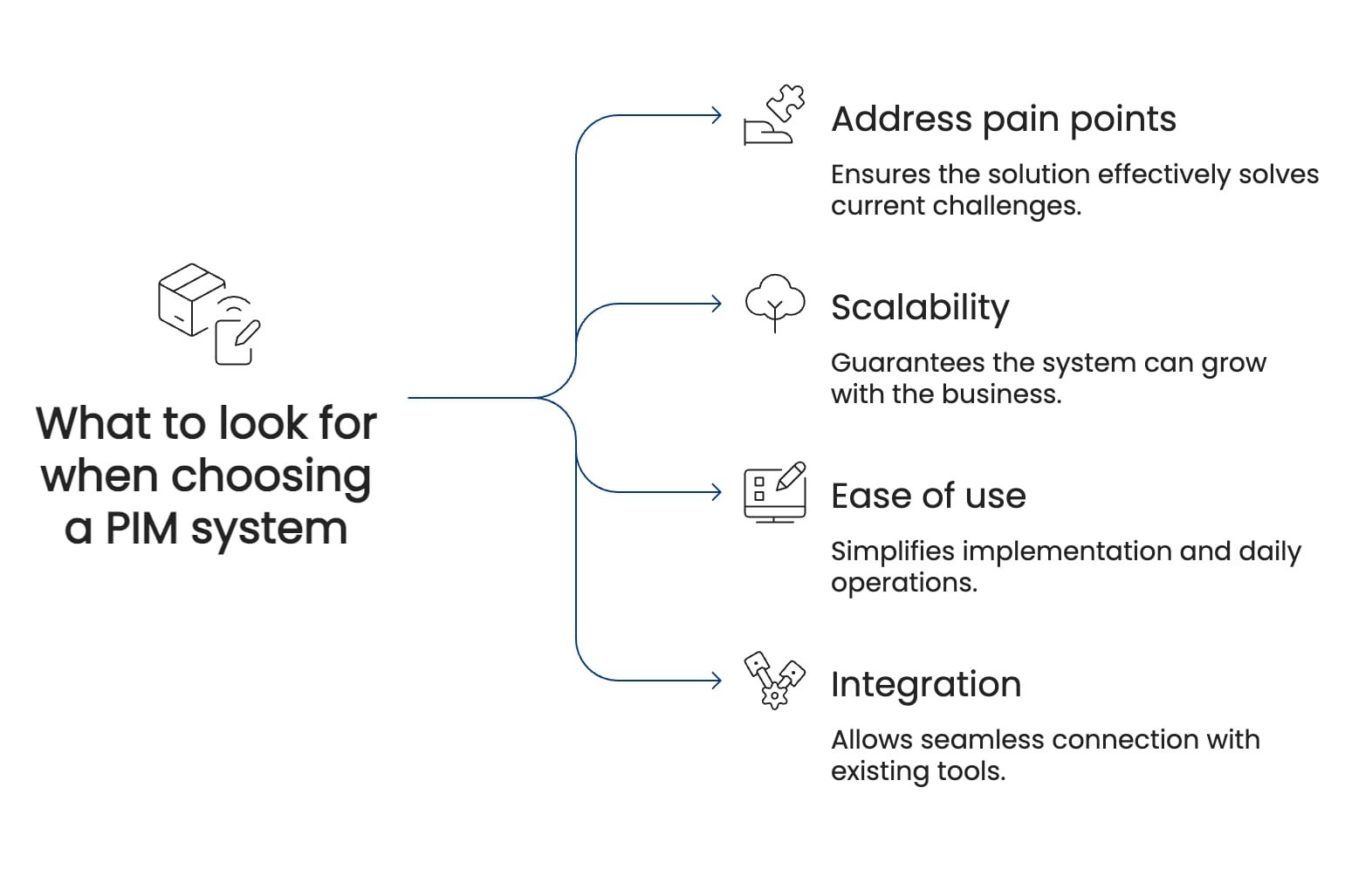Answering the title shortly, project information management software improves product data accuracy and boosts sales a lot! Simply put, PIM solution benefits and straightforward nature can greatly improve tons of product-related processes in your product.
In this article, we’ll look deeper into how exactly PIM does so. We’ll outline what it is, how it works, and how you can leverage its effectiveness. Let’s get started with the basics.
Understanding Product Information Management (PIM)
PIM is a software system for centralized product data management. It lets users collect, manage, enrich, and distribute data across various sales and marketing channels. Considering that modern commerce has become multichannel, the demand for such systems is huge and continues to grow.
So, how does it work? At its core, a PIM system acts as a single source of truth for all content about your products. It collects product names, descriptions, specifications, pricing, images, videos, and marketing content, organizing a solid product taxonomy structure.
Thus, this centralization reduces any need for manual information updates. Instead, you can easily manage all content in one place, with it being updated everywhere. Notably, PIM platforms are super valuable for businesses with large or frequently changing catalogs, operating in multiple regions or languages.
The impact of accurate product data on sales
Customers expect detailed, reliable, and consistent product information at every touchpoint. Frankly speaking, the accuracy of product data directly impacts their buying decisions.
Customers are more likely to believe a product and go through the checkout process if the details, measurements, materials, and pictures are all shown in a clear and consistent way. On the other hand, information that is missing or doesn't make sense can make people hesitate or leave their shopping cart.
Correct information about the products is also very important for lowering the number of returns. Many returns happen because of wrong descriptions, features that don't work together, or sizes that aren't clear. So, if you have full and up-to-date product information, you can better match what customers expect with what you actually offer.
Moreover, thanks to PIM, consistency across all channels enhances the overall shopping experience. When info is uniform on your website, marketplace, and social media, customers enjoy a seamless journey and are more likely to convert.
From a sales perspective, this translates into benefits:
- Higher conversion rates;
- Increased average order values;
- Stronger brand loyalty.
In the end, everything is simple. PIM can easily provide accurate data. This accuracy generates trust, while the latter generates more sales. More trustworthy experience then encourages repeat purchases.
Read also: Why Your Ecommerce Business Needs a PIM System: Key Benefits & Use Cases
How PIM ensures product data accuracy
Centralized data repository
At the core of every PIM system is a centralized data hub. Instead of managing product information across disconnected spreadsheets, databases, or content platforms, it allows you to store and update everything in one place.
Thanks to this approach, all teams use the same information and can sync on it. This prevents inconsistencies and reduces data entry errors.
Product data standardization and validation
PIM systems enforce predefined data structures and formatting rules across all products in the system. They, for instance, set required fields, approve attribute types, measurement units, and naming conventions.
What’s handy is that validation rules can automatically flag incomplete or incorrect entries, leaving them behind and publishing only clean, standardized data. As a result, businesses maintain uniform product information across thousands of SKUs, even in complex catalogs.
Real-time data synchronization
What can be better than all data synchronized in one place? Right, this data is synchronized in one place!
One of the most valuable features of a PIM system is its ability to synchronize product data in real time across all connected channels. Simply put, any change made within the PIM system, like a price update, product description edit, or image replacement, is immediately reflected everywhere the product is listed.
| How PIM ensures product data accuracy | |||
| Characteristic | Centralized data | Standardization and validation | Real-time sync |
| Description | Acts as a single hub for all product information | Enforces data rules and formatting | Reflects updates across all channels |
| Benefit | Prevents inconsistencies and errors | Flags incomplete or incorrect entities | Price, description, and image updates |
Measuring ROI: the business impact of PIM implementation
The impact of PIM integration should be measurable. Fortunately, there’s a lot you can track: key performance indicators (KPIs) across sales, operations, customer experience, and more. With all this data, you can clearly quantify the return on investment (ROI) delivered by PIM.
Sales performance metrics before and after PIM
With improved data accuracy metrics, completeness, and consistency of product information, PIM systems directly influence your sales outcomes. Thus, some time after implementation, you can expect:
- Optimized conversion rates due to clearer product details;
- Higher average order values (AOV) from better cross-selling and bundling;
- Revenue growth from faster product launches and broader channel coverage.
Operational efficiency
PIM is great for product data workflow automation. It can significantly cut the time spent on fixing bugs and management. Instead, this time is allocated to improve your operational processes. Thus, you can expect:
- Significant time savings in content creation and product updates;
- Fewer internal errors and rework caused by data mismatches;
- Increased productivity as teams collaborate on a shared platform.
Customer experience enhancements
With product content optimization, you can create a super smooth shopping experience, where nothing interrupts users’ flow. In this regard, PIM implementation often brings:
- Reduced customer service inquiries due to better product clarity;
- Fewer returns linked to misinformation;
- Higher satisfaction scores and repeat purchases.

Selecting the right PIM solution for your business
PIM systems come in different types, with different prices and benefits. You might not know what to look for, which can make it hard to pick the right one. The best PIM system should fit the size of your business, the way you handle your catalog, and your plans for growth. To sort through the many systems available in the market, ask the right questions.
What pain points do you have?
Do you have a lot of data to manage across too many spreadsheets? Are errors slipping into listings across platforms? When it comes to product data governance, the PIM system you choose should have direct solutions to these pain points.
Is it scalable?
Choose a system that not only fits your needs now but can also grow with you. Look for custom, modular platforms built with MACH architecture that allow you to add new features in the future. Naturally, you will want to add multilingual support, digital asset management (DAM), or new third-party integrations.
Read also: PIM vs. ERP vs. DAM: Understanding the Differences and When to Use Each
Is it easy to use?
Product onboarding efficiency and ease of use are equally important. A clean interface, UI/UX consistency, and intuitive features allow your teams to adopt the new tool quickly, especially if you lack in-house technical support.
Is it possible to connect it to the tools you already have?
Lastly, look at how well merging works. To get rid of data silos and cut down on repetition, your PIM should work well with your ecommerce platform, ERP, CRM, and marketing tools.

Conclusion
Regardless of what product you operate, if there are any goods involved, PIM would be a great addition for product data enrichment. Many off-the-shelf solutions can cover your needs, but may also fail you in the long run. Thus, it’s always preferable to look into custom-built PIM systems.
At Codica, we professionally develop various software solutions, including product inventory management systems. Our custom software development services employ a broad range of tools and practices to deliver performant, reliable, and scalable solutions. Contact us to get a quote, see approximate prices, and get a detailed look at how we will tackle it. In the meantime, feel free to check out our portfolio, which clearly demonstrates the power of modern software development services.
